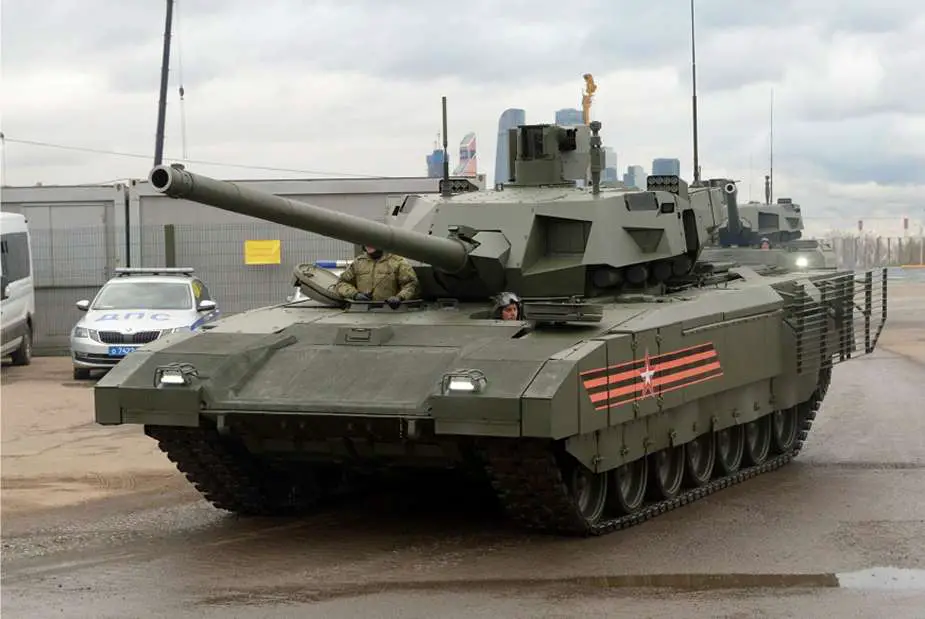Breaking news
T-14 Armata tank reaches last development stage before mass production.
According to TASS on August 22, 2023, sources within the military-industrial complex confirmed that the T-14 Armata tank will finally enter into its finalization phase, which is the process of completing or perfecting the development, design, and production of a vehicle to render it prepared for operational deployment. This phase will integrate the learnings from its involvement in combat operations as part of Russia's battlegroup South. However, the source didn't specify the precise nature of these planned alterations.
Follow Army Recognition on Google News at this link

T-14 Armata tank reaches last development stage before mass production (Picture source: Yandex)
On July 19, 2023, the Army Recognition editorial team reported the active but experimental involvement of T-14 Armata tanks in combat operations as part of Russia's battlegroup South. However, due to limited visual evidence, this information sparked discussions about the potential deployment of these tanks in Ukraine for combat purposes. According to TASS, the primary aim of the deployment was to assess its performance under authentic combat conditions. After this assessment, the tanks were withdrawn from active duty on the front lines.
On April 2023, the Army Recognition editorial team disclosed the deployment of Russian T-14 Armata tanks in Ukraine, ostensibly as a response to Ukrainian forces. However, up until that juncture, these tanks had not engaged in direct offensive missions. Finally, in February 2023, the Army Recognition editorial team reported the commencement of Russian soldiers' training with T-14 Armata tanks, in preparation for potential deployment to Ukraine.
Within the context of military vehicles, the term "finalize" typically denotes the process of completing or perfecting the development, design, and production of a vehicle to render it prepared for operational deployment. The significance of finalizing a military vehicle is of paramount importance for several reasons.
Finalizing a military vehicle entails subjecting it to all essential testing, evaluation, and adjustments to ensure compliance with requisite standards of performance, durability, and reliability. This step is pivotal in ensuring the vehicle's readiness for deployment in diverse operational scenarios. Military vehicles are designed and constructed with specific tasks and missions in mind. Finalization involves refining the vehicle's design and functionality to ensure their effective execution of intended tasks, whether encompassing transport, reconnaissance, combat, logistics or any other mission profile.
Given that military vehicles often function in arduous and perilous environments, including active conflict zones, finalization encompasses optimizing the vehicle's protective features, encompassing armor, blast resistance, and other survivability measures, all contributing to heightened safety for the personnel within the vehicle.
Modern military vehicles are intricate machines that incorporate a wide array of advanced systems, encompassing communication, navigation, weaponry, sensors, and more. Finalizing the vehicle necessitates ensuring seamless integration, calibration, and testing of all these systems to guarantee their harmonious functioning.
Upon finalization of a military vehicle, the establishment of maintenance and support protocols becomes more streamlined. This encompasses devising maintenance schedules, plans for procuring spare parts, and training programs for the personnel responsible for operating and maintaining these vehicles. On August 5, 2023, the Army Recognition editorial team documented the presence of a T-14 Armata main battle tank near the Kazan Higher Tank Command Order of Zhukov, an institution with a history of training specialized command personnel for Russia's armored and mechanized forces. This tank was observed adorned with the distinct Russian tri-color AFV camouflage.
The finalization phase frequently represents the concluding stage in a project's development life cycle. Timely completion of this phase within allocated budgets and timelines is imperative to avert cost overruns and delays.
In military operations, vehicles often collaborate with other military assets, encompassing different vehicles, aircraft, and communication systems. Finalization ensures compatibility of the vehicle with other military equipment, facilitating effective communication and coordination. On August 18, 2023, the Army Recognition editorial team reported the initial public demonstration of the T-14 Armata during the Army-2023 event.
Throughout the development process, military personnel who will use the vehicle offer feedback regarding its performance and functionality. Finalization necessitates incorporating this feedback to address any issues or concerns highlighted by end-users.
The T-14 Armata, an advanced next-generation main battle tank developed by Uralvagonzavod, materialized from the Armata Universal Combat Platform initiative, aimed at conceiving a versatile and adaptable combat system tailored to various roles. Unveiled publicly during the 2015 Victory Day Parade in Moscow, the T-14 Armata has since undergone rigorous testing and trials. It is destined to gradually supplant Russia's aging tank models, in consonance with the nation's military modernization strategy.
The T-14 Armata boasts an unmanned turret housing the primary armament and autoloader, while the crew of three is situated within an armored capsule at the hull's forefront. This design choice prioritizes crew safety and minimizes the tank's overall battlefield profile. Outfitted with a sophisticated fire control system integrating data from diverse sensors, including high-resolution cameras, thermal imagers, and laser rangefinders, the T-14 Armata aims to enhance target acquisition and precision.
Its modular design, rooted in the Armata Universal Combat Platform, enables potential customization to fulfill varied roles, ranging from infantry support and reconnaissance to heavy assault. Defensive capabilities encompass composite armor, explosive reactive armor, and an Active Protection System (APS) named Afghanit, proficient in detecting and intercepting incoming projectiles.
Powered by a 1,500-horsepower diesel engine, the T-14 Armata can attain speeds of around 56 mph (90 km/h), with an advanced suspension system bolstering maneuverability and off-road performance. Moreover, the tank's blueprint facilitates operation within a networked battlefield environment, facilitating communication and data exchange among diverse military units.



















